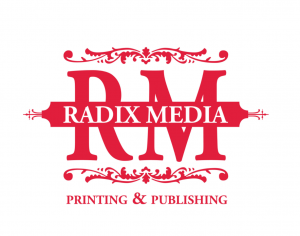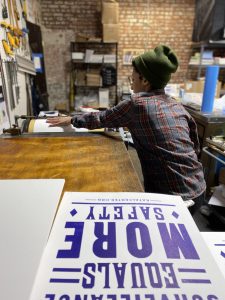We spoke with the owners at Radix Media—Lantz Arroyo, Nicholas Hurd, and Sarah Lopez—in this installment of the CLMP Member Spotlight series.
What is the history behind Radix Media? When was it founded and what is its mission?
 Radix Media began in the Pacific Northwest as a small company designing posters and flyers for social justice organizations. Lantz Arroyo had become interested in the printing process while working at the Red and Black, a worker-owned cafe and event space, followed by an apprenticeship with Eberhardt Press, a print shop and publisher based in Portland, Oregon. He immediately fell in love with print! Shortly after his apprenticeship, Lantz bought his own offset press and learned how to use it. The organizations he’d been previously designing for became some of Radix Media’s earliest print clients.
Radix Media began in the Pacific Northwest as a small company designing posters and flyers for social justice organizations. Lantz Arroyo had become interested in the printing process while working at the Red and Black, a worker-owned cafe and event space, followed by an apprenticeship with Eberhardt Press, a print shop and publisher based in Portland, Oregon. He immediately fell in love with print! Shortly after his apprenticeship, Lantz bought his own offset press and learned how to use it. The organizations he’d been previously designing for became some of Radix Media’s earliest print clients.
After establishing his roots as a printer in Portland, Lantz relocated to New York City in 2011, where he was connected with the folks from OccuCopy, a worker-owned print shop born out of the Occupy Wall Street movement. Their focus was more on quick turnaround digital printing, whereas Lantz was more experienced in offset printing, so the two groups had complementary skills and decided that joining forces would be better for everyone—including the community. Many of the folks involved in OccuCopy moved on to other projects, but in 2017, Radix Media merged with Wasp Poster & Print, a letterpress and design studio. We expanded into literary publishing the following year.
Keeping with the name Radix, which comes from the Latin root of the word radical, meaning to get to the root, we aim to get to the root of the human experience by publishing the voices of marginalized and underrepresented communities.
This year marks the tenth anniversary of Radix Media as a printer, and your dual nature as a printer and publisher allows you to produce all of your titles in-house. What are some of the rewards and challenges of this pairing? How does this affect your editorial process and your vision?
 Having the ability to produce all of our titles in-house is really helpful for a number of reasons. It allows us to be more flexible with our production schedules and edit right up until it’s time to print. We can also cut down on costs without losing quality and have more control over the finished product.
Having the ability to produce all of our titles in-house is really helpful for a number of reasons. It allows us to be more flexible with our production schedules and edit right up until it’s time to print. We can also cut down on costs without losing quality and have more control over the finished product.
We wish that there were more examples of printer-publishers, because we can have a more holistic approach than traditional publishers. We’re able to start thinking about the final product as soon as we decide that we want to publish someone. We also bring them into the conversation and give them a say in what their book will look like.
We’re still operating as a commercial print shop, so it can be challenging to find enough hours in the day to do all of the work of both a printer and publisher; we’re essentially running two businesses with four people under one roof. It’s not easy! It’s a ton of work, and much of it is invisible to the average person. But the pros definitely outweigh the cons.
Can you tell us a little about your emphasis on sustainability? How is your printing process eco-friendly?
On the production side, we aim to use recycled paper whenever possible—much of what we use is 100% post-consumer waste, with most of the rest being somewhere between 30 to 60% recycled. We use vegetable-based ink in our offset and letterpress machines. But more than that, we really try to use everything we can. We place bulk paper orders to reduce the number of deliveries we get and often turn paper scraps into notebooks and other pieces of stationery.
Why is it important that Radix Media is worker-owned? Does this impact your editorial decisions?
 We think it’s important for all workers to have autonomy and reap the benefits of their labor. Being part of a cooperative ensures that. Worker cooperatives are not the magic solution to all of publishing’s woes, but we do think that the cooperative structure would do a lot to address the income inequality and lack of diversity in publishing. The history of worker coops is intertwined with labor history and struggles toward racial equality, so a commitment to equity is inherent to the cooperative structure.
We think it’s important for all workers to have autonomy and reap the benefits of their labor. Being part of a cooperative ensures that. Worker cooperatives are not the magic solution to all of publishing’s woes, but we do think that the cooperative structure would do a lot to address the income inequality and lack of diversity in publishing. The history of worker coops is intertwined with labor history and struggles toward racial equality, so a commitment to equity is inherent to the cooperative structure.
Everyone at Radix has an equal voice, and we make our decisions as a collective. We think it makes our catalog stronger because we can workshop our ideas and get constructive criticism if something doesn’t seem quite right. There’s a lot of inequity and gatekeeping in publishing. Who knows how different the industry at large would look if there were more voices at the table? Many wonderful books could have been brought into print, and many others may not have seen the light of day.
You’ve just launched a Kickstarter campaign to fund three upcoming graphic narrative projects. Can you tell us more about this?
 In 2021 and 2022, Radix Media will be releasing three distinctively unique graphic narrative projects from Ganzeer, Molly Crabapple, and the team of John Dermot Woods and Matt L. Each of these projects explores the prescient themes that concern our lives: urban isolation, the failures of capitalism, and restorative and transformative justice.
In 2021 and 2022, Radix Media will be releasing three distinctively unique graphic narrative projects from Ganzeer, Molly Crabapple, and the team of John Dermot Woods and Matt L. Each of these projects explores the prescient themes that concern our lives: urban isolation, the failures of capitalism, and restorative and transformative justice.
Comics are a great storytelling vessel. It was one of our goals from the beginning to eventually publish graphic narratives. We just needed to find the right projects: compelling stories that we could produce successfully. Because we print in-house, the specifications of the book—size, page count, and interior design—really matter. All three books in this collection are by people we know and respect, and in some cases we have worked with them before. John Dermot Woods wrote Always Blue, the first title in Futures: A Science Fiction Series. It’s great to be working on a longer project with him. Ganzeer illustrated our most recent title, We Are All Things, written by Elliott Colla. So as we work with more people, our brains start percolating and looking for other ways to collaborate.
As for the Kickstarter, we encourage people to visit our project page to learn about the Radix Media Graphic Narrative Collection and see all the fun rewards we have lined up, including our back catalog, postcard sets, and lots more.
What are some of your hopes and goals for the next ten years?
We’d love to continue building our catalog and eventually be publishing more than one or two titles per year. We would love to publish more comics and dip our toes into other genres, like the graphic memoir. And if we’re going to dream big, it’d be great to own a multi-use building that includes a bookstore and event space. Who knows if we’ll survive the pandemic, but maybe we can manifest it into reality.
